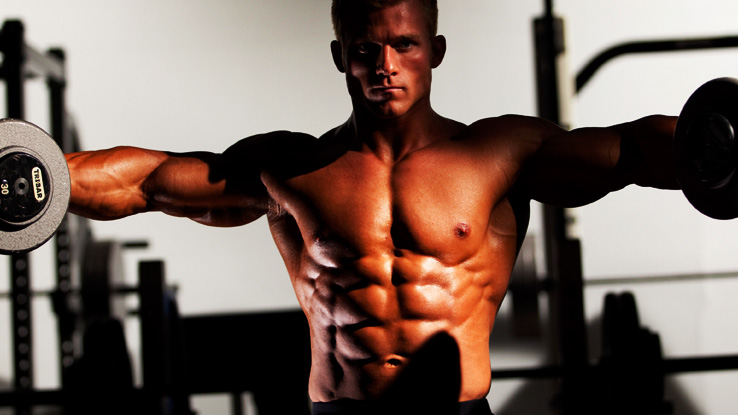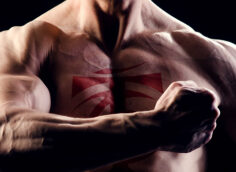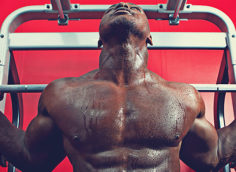Loaded isometrics can teach you a great number of things. The lesson I always learn is that I'm not as strong or as tough as I think I am. It's always a humbling experience to feel a whole new level of pain from a familiar exercise and it's a good check to see if you're actually working on your weak areas or just on the exercises you like.
Loaded isometrics are also fantastic for teaching the concept of irradiated tension, which, when properly performed, can increase strength gains in almost every exercise. The basic premise of irradiated tension is the idea that the body does not function in single units, but that the entire structure is important for even the smallest isolation move. In other words, when you create tension through your whole body, a dumbbell curl is more than just a dumbbell curl.
To create this next-level type of tension through your whole body, assume an athletic stance, feet shoulder-width apart, knees slightly bent, and starting with your core, begin to tighten your abs and then your glutes to create a foundation. Then squeeze the quads, pull the shoulder blades down and back, engage the lats, and lastly, tighten both fists.
Make sure you're taking small shallow breaths and then take inventory of your body. You should feel like an immovable object. If you need more proof that this technique will allow you to lift more, do a single arm dumbbell press with your weaker arm. Try it once without the tension, and try it once with it. Make up your own mind.
Here are several exercises that will teach you to use your entire body as one unit, test your mettle, and build strength in several key areas that most lifters lack. You can do these moves after your main lift for the day, as a finisher that will cause a ridiculous amount of lactic acid buildup, or just to test your willpower.
These moves can be done to increase either muscle size or strength, depending on the load used and the time under tension. When strength is the focus, keep your sets between 10-15 seconds using as much as 150% of your max load (although that can be difficult on some of these without a spotter). Use these guidelines when finding your poundages, but remember that you can always do longer holds if you've underestimated your strength.
- To build strength: Use 85%-115% of 1RM and hold for 10-15 seconds.
- To build muscular hypertrophy: Use 50%-80% of 1RM and hold for 40-60 seconds.
- To build muscular endurance: Use 25%-60% of 1RM and hold for 60-180 seconds.
No matter what the focus is, identify what muscle group you're working and make sure to keep those muscles mentally engaged and bearing the majority of the load during the entire time under tension.

To do these, grab a dumbbell or kettlebell and hold it in a goblet position at your chest. Exposing yourself to an anterior load instead of dumbbells held at the side or a barbell on your back increases the amount of rectus abdominus activation, which is helpful if you're planning on being shirtless this summer.
Hold yourself with your front leg at 90 degrees, or just slightly higher, set the timer, and prepare to become very sad, very fast. A strong male lifter should be able to use a 45-pound dumbbell or kettlebell in front of his chest for 60 seconds.

Just holding your body weight with maximal tension irradiating throughout your entire body can be a challenging move, so make sure you've mastered that before moving on to an external load. Having a partner is key for this exercise so that you're able to create full body tension before the weight is added. A weight vest works well here, but it's difficult to find a challenging weight without breaking the bank. I use a plate with the top of the plate set right below the scapula and the bottom of the plate resting on the top of the glutes.
Make sure the abs do the work here by concentrating on forcing the front of your ribs down. Low back extension is not allowed. Since many of the core muscles are postural and made up of slow-twitch muscle fibers, go for an endurance range. Shoot for 60 seconds with a 45-pound plate.

The lateral raise dumbbell hold, or crucifix, is a favorite exercise of strongmen to build shoulder and rotator cuff strength and it requires a good amount of testicular fortitude. To do this move, hold two dumbbells out at your sides at shoulder level. Make sure they're held at 90 degrees and no higher. In order to increase the stress on your lateral deltoids, rotate your hands so that your thumbs are pointing towards the ground and your elbows are just slightly higher than your hands. As the set progresses, you can decrease the mechanical intensity (and thereby lengthen the duration of the set) by rotating your hands externally so that you end with your palms facing forward and the thumbs pointing toward the ceiling.
As with every loaded isometric, make sure to increase the irradiated tension throughout your body by squeezing the glutes and abs and making sure to eliminate any low back arch that may develop throughout the set. Shoot for 60 seconds with 15-pound dumbbells.
The front squat iso hold can be done in two different positions and can serve two different purposes.
Top Hold

This is a move that ultimately taxes the upper back and core and can leave you with DOMS in muscles you didn't know existed. This can be done as a finisher after a leg or back workout, or as an accessory movement that can help increase deadlift strength and back thickness. Do this move with 100% to 150% of your 1RM. Make sure that your entire body is tight before lifting the bar off the hooks and once it's lifted, don't step back. Stay right above the hooks and focus on keeping the torso and glutes engaged while breathing.
Every time I use this move in my program, all my other lifts seem to increase, and I need fewer glute and low back corrective exercises. Start slow on this one, but a strong lifter should be able to hold his 1RM for 60 seconds.
Bottom Hold

This move will help build flexibility and strength through the legs and the core, but it'll need to be much lighter than the heavy top-hold variation. Start with 25% of your 1RM and gradually build from there. Make sure to stay as close to 90 degrees as you can, even if getting ass-to-grass is easy for you from a mobility standpoint. Most lifters I see with this type of mobility can just rest their hamstrings on their calves. That can take the load from the quads and shift it to the knees, which defeats the purpose.
Focus on sitting down between your legs, and not behind them. If mobility is an issue for you, start higher and let the weight pull you down into a deeper squat position by driving your knees out to the side. Shoot for 30 seconds with 40% of your 1RM.
Loaded isos are a way to intensify different moves as well as increase full body strength or build muscle. Do these after your main lift or use them as a finisher. If you've never done these before, start slow and gradually build, because many of these moves can make you sore for a week afterwards if you start with a weight that's too heavy.
Make sure you're keeping the entire body tight on each of these moves. Remember, we're building total body strength. Lastly, make sure you keep your mental focus on the muscle that you're working. Build your mental focus and you will become strong.





